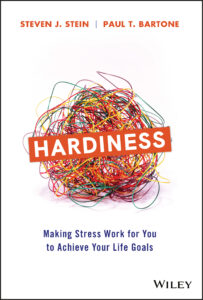Develop a New Mental Framework
Feeling stressed? Can you make that work for you?
What if you could develop a trait that would help you master stressful situations so you could become more successful?
In their new book, Hardiness: Making Stress Work for You to Achieve Your Life Goals, authors Steven J. Stein and Paul T. Bartone tackle these questions. I spoke to them about how to tap into hardiness for this very purpose.
For those who haven’t yet read your new book, what is hardiness?
Hardiness is a mental framework, a mindset that powers people to be resilient and stay healthy under stress. Since its discovery by University of Chicago researchers some 40 years ago, thousand of scientific studies have proven that people high in hardiness not only cope more effectively with stress, but often grow and thrive as a result of stressful encounters.
You share three facets of hardiness-commitment, control, and challenge. Would you share a little about these?
This is what we call the three Cs of hardiness.
Control is the ability to control what’s going on in your life, the belief that what you do makes a difference in how things turn out. Being high in control means you like to take action to solve problems and get things done.
Challenge is about flexibility. People high in challenge like to try out new things; they see stress as not necessarily a bad thing, but something that is challenging that they can deal with and learn from.
Commitment is about having a strong sense of purpose and meaning in life. People high in commitment are engaged and interested life and the world around them.
Many may think hardiness is the same as resilience. How are the concepts similar and different?
Many factors can help people to be resilient, which is the ability to bounce back quickly from hardships and adversity. For example, social support from friends and family helps people to be resilient under stress. But hardiness is the main internal or “inside the skin” factor that leads to resilience. Resilience is the “what”… bouncing back from stress. Hardiness is the “how”…. How people get to be resilient in the first place.
How do you measure it?
We measure hardiness with a standardized instrument called the Hardiness Resilience Gauge, available through MHS Assessments in Toronto. It’s a self-report test that takes about ten minutes to complete and has proven scientific valid and reliable in nationwide representative samples. Test results show you where your hardiness levels are on each of the three Cs, the test includes strategies and tips for how to develop and strengthen your hardiness levels. The HRG is the result of over 30 years of research and development on measuring hardiness.
What are a few ways you can learn to increase your hardiness?
Here are some things that you can do to increase your hardiness mindset and start to benefit from the stressors and changes in life.
Commitment:
-Take time to reflect on what’s important and meaningful in your life and set some goals
-Find out what you love and do it!
-Pay attention, learn about the world and people around you
Control:
-Take on jobs that are within your wheelhouse and skill set
-Break up big jobs and tasks into smaller pieces, so you can see progress and success
-Don’t be afraid to ask for help when you need it
-Recognize and feel good about your achievements and successes
Challenge:
-Don’t live every day by a rigid schedule; inject some variety into your life
-Try out new things, take reasonable risks
-When you fail at something, don’t beat yourself up about it. Look for ways to learn from the experience
What does a hardy leader look like?
The hardy leader demonstrates a hardy mindset in how he or she reacts to stress at work. First and foremost, as a leader you should set a hardy example. Be a role model for hardy responses to stress. People learn by watching each other, and they pay special attention to their leaders. As a leader, you need to show that you’re engaged and interested in what’s going on, and not just in the work but in the people who are doing the work. When confronting problem situations, you take action to solve the problem. And always show an interest in trying new things, and also learning from failures. A leader’s style, positive or negative, is contagious.
How can leaders help improve hardiness throughout the organization?
Leaders can create or shape the work environment to encourage a hardiness mindset – commitment, control and challenge – in the entire organization. They create a culture of hardiness.
Build commitment by seeking subordinates’ ideas and feedback, letting them know their input is important. Also keep the workers informed about what you’re doing and why. This is one of the easiest things to do to build commitment, but so many leaders fail to do it. And give recognition for positive accomplishments.
That also imparts a greater sense of control. Don’t micromanage. Allow your staff opportunities to take initiative and decide how to go about getting a job done.
As a leader there are several good ways to build challenge. Provide flexibility in the schedule wherever possible. Allow and encourage your workers to try new approaches, new ways of getting things done. And critically, when someone fails or a deadline is missed, discuss it with the employee and look for ways to learn from the experience and improve in the future.
For more information, see Hardiness: Making Stress Work for You to Achieve Your Life Goals.
Image credit: Mike Petrucci

